





Tired of the same old assortment of pots for your burgeoning collection of succulent plants? We were. Good choices for potting succulents are rarely available and at many standard nurseries or garden centers. The following article is a discussion of some solutions to this problem and a pictorial introduction to some of these 'other' pots.
Thanks to a rapidly depleted yard in terms of space we have had to resort to putting many plants into pots, a less than ideal situation for me personally as I have a brown thumb when it comes to keeping potted plants alive. I am sure this is due to lack of diligence and ignorance more than some curse upon my being.... But I am not totally sure about that. I also have an unfounded nagging worry that the plants would be happier ‘free' of their potted restraints. When it comes to palms and cycads, this may probably be true though both plant varieties tend to perform quite well in pots... just a lot better in the ground. But as my budget shrinks along with the available space, most of my collecting has evolved to include primarily succulents, far cheaper and usually smaller plants than are palms or cycads. Anyway, most of the plants we collect are succulents which, for the most part, lend themselves perfectly to potted situations. Not being one with a taste for the ‘same-old' sort of thing, I have avoided collecting the same sorts of pots for our succulents over and over again. In retrospect this was perhaps not a wise move from a classical aesthetic point of view, and has had a tendency to make the back yard look a bit irregular... but far more interesting as far as I am concerned. And since rarely does another human venture into that morass, we are perfectly content with our odd assortment of pottery. Perhaps some readers are of a similar bent, and this article is for them.
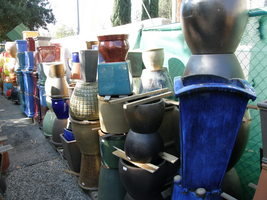
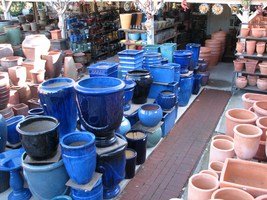
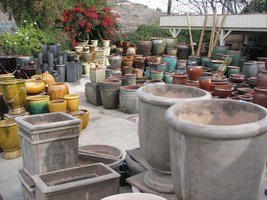
Typical pot selections at some of the more well stocked nurseries here in Southern California- WAY better than most home and garden centers, but still not excactly catering to the succulent plants or me
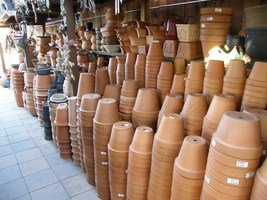
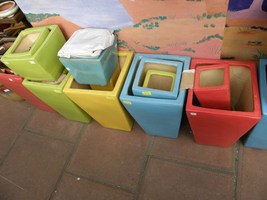
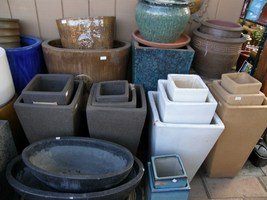
Even succulent nurseries don't always have what we want... tons of terra cotta and lots of tall, skinny pots- we use these, but prefer somethings more suitable or different
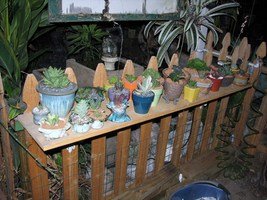
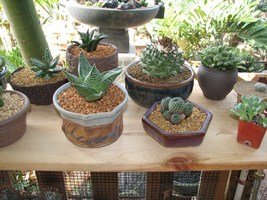
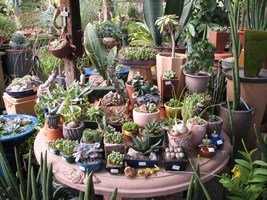
These are more like the pots we're always looking for- small and suitable for succulents
One thing that befuddles my girlfriend and I every time we go on the search for suitable pots is the lack of variety and the lack of pots designed for succulents. Succulents in general require a very well draining soil and, preferably, a pot that does not retain an excessive amount of water. Succulents, in my limited experience, tend to do best in low, wide pots. Deeper pots are mostly a waste of soil as far as succulents are concerned, and take much longer to dry out their soil contents vastly increasing the opportunity for rot to take place. So we are constantly on the lookout for low, wide pots, apparently the very opposite design 99% of the world's pot manufacturers consider the ideal configuration. And to add to our frustration, when we do stumble upon at attractive low, wide pot, more often that not there is no hole in the bottom. To this day I still do not understand the reason for this and it irritates me so much that I have never asked a nursery type for an explanation of this odd situation. What does one grow in pots without holes?
Anyway, we have worked out a few strategies to deal with this lack of decent available pottery for our succulents (and other plants as well... we still have some cycads, palms and ‘regular plants' in pottery).
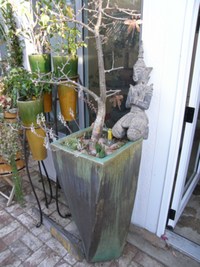
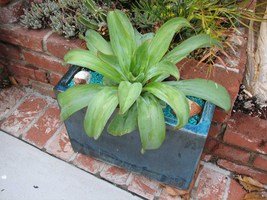
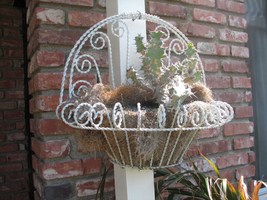
Using 'normal' available pottery in unexpected ways sometimes is fun. The tall pot is not necessarily a good for planting a rot-prone tree like that Bursera, but 3/4 of the pot is full of gravel so drainage is excellent; in the second photo a large, round rosette was planted in a tall, narrow, flat pot which seems somewhat incongruous at first... but it's a good pot for such a plant and the contrast of shapes is interesting. One rarely uses hanging baskets for succulents, but they are actually probably better suited for succulents than most other plants as these dry out so fast it is sometimes hard to keep other types of plants happy in such containers... but this Euphorbia is doing pretty well in this one so far
One thing one can do to keep from being limited by the lack of available low, wide pottery is to take these bizarre un-holed pots and simply drill a hole in them. When I say simply, I mean the concept is simple. Drilling the hole is sometimes not. I have a high speed drill with a chuck to tighten the bits (self tightening or hand tightening rarely is sufficient for drilling solid ceramics, rock or concrete). And I have a set of drill bits that are designed, supposedly, for drilling super-hard materials like these. Designed perhaps, but usually poorly created in my experience. These carbide-tipped drills are usually relatively dull and any sharp edges they may have come with disappear after drilling the first 1-2 pots. A large platform drill press would probably be the ideal machine to use, but haven't the room for such bulk.
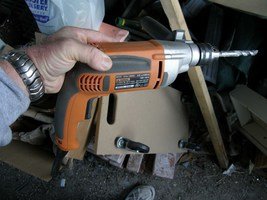
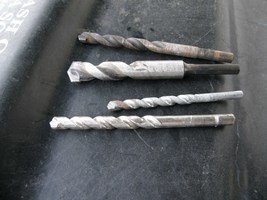
My drill I use to make drainage holes, and the special ceramic/cement drill bits (bits made with the 'normal' metals tend to break easily)
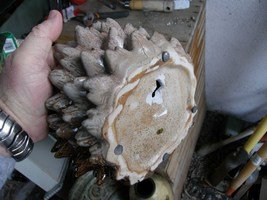
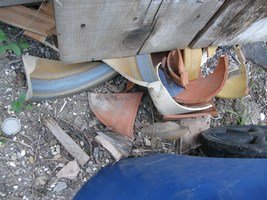
Things don't always go well though- here is a pot that cracked during drilling (extremely hard ceramic material) and several more failures tossed into the yard for use later on as something else
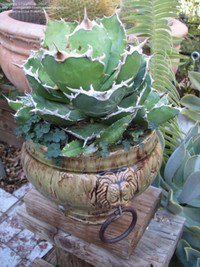
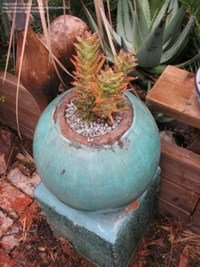
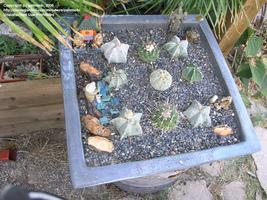
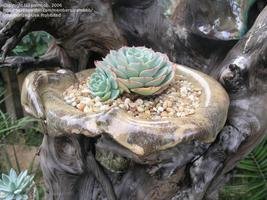
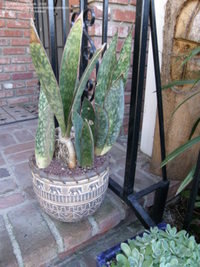
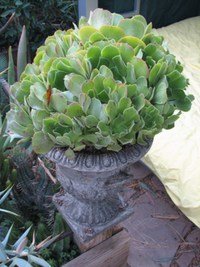
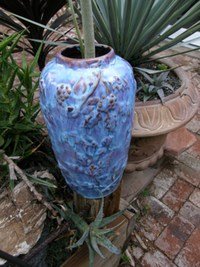
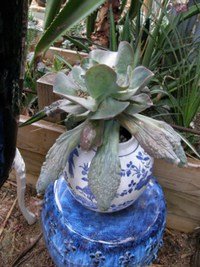
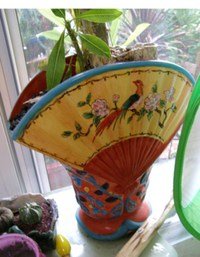
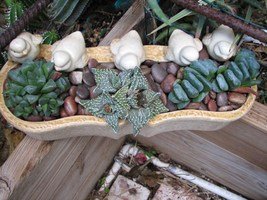
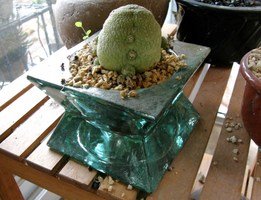
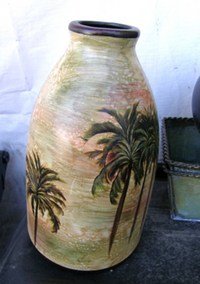
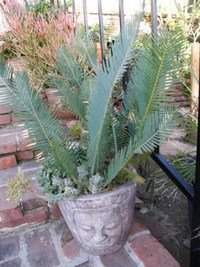
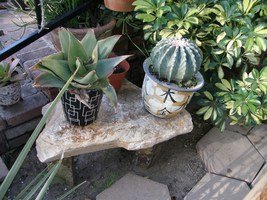
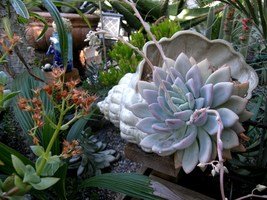
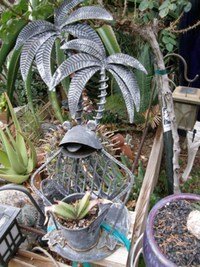
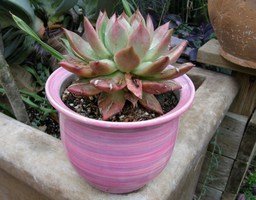
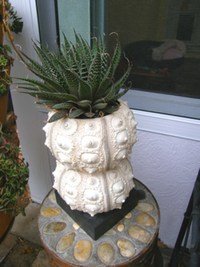
All the above pots are examples of pots that were available at cheaper outlet or resale stores but obviously not meant fot putting live plants in, as none had drainage holes in them (with the exception of the turquoise sphere, which was supposed to be a fountain). The large square pot on the upper left was an especially large catch basin for a large square pot... but it's a perfect shallow pot for multiple cacti. The porcelain blue and white pot and small green glass ones were particularly challenging to drill, but I got lucky and didn't break them. The tall palm-painted pot is not an ideal succulent pot, but unique enough to use anyway for something suitable. The bottom right photo is of an aloe planted in a plastic shell... no idea how long that will last but sure was easy to drill a hole in.
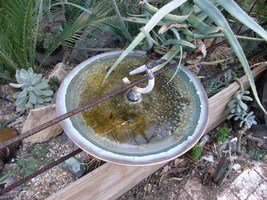
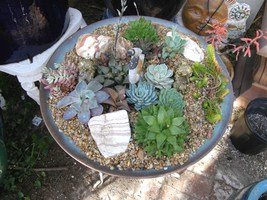
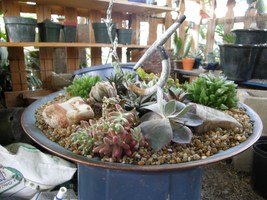
This sundail/birdbath was sort of taking up valuable space, so girl-friend drilled some drainage holes in it and made it into community pot. Side view shows how shallow this pot is... pretty ideal for many succulents.
I set the pots down on a softer surface (concrete will sometimes damage the lips of the glaze or material, and the unyielding surface increases the likelihood of shattering the entire pot from the force of the drilling... I am the owner of large piles of shattered pots thanks to unsuccessful drilling attempts... but these make for excellent chunks of clay to pot at the bottom of pots to keep dirt from pouring out the holes, or to add to a potting mix if smashed up a bit more finely) and drill until I have a hole through the bottom. Sounds simple enough... only some pots are made of extremely drill-resistant materials. I have not had much luck drilling through porcelains or glass, even with the newest bits. Usually I either end up with an intact pot with a hint of drill spot, or a pile of shiny, sharp shards. But many ornamental pots, designed for indoor use (primarily as holders of dried flower arrangements or for food use) are made of softer, easier to drill materials (soft clay, metal, plastic etc.) and drilling a hole is routine. I drill as large a hole as I can get away with to prevent rot from poor drainage. Drilling drainage holes increases ones choices of pots 100 fold and certainly opens the door for many unique, whimsical and bizarre pot designs. If there are some adjectives that best describe my plant and pottery collection, those would certainly be included.
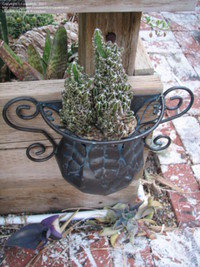
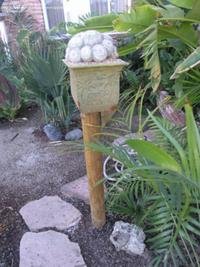
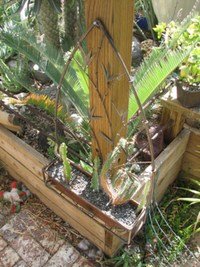
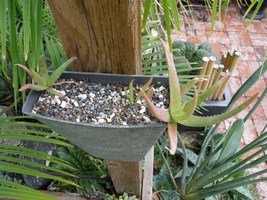
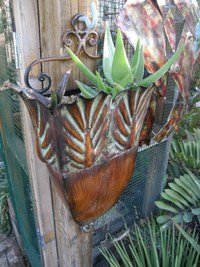
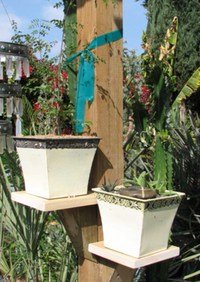
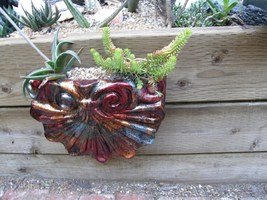
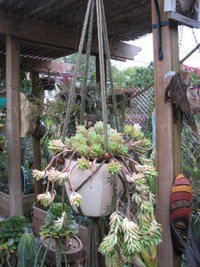
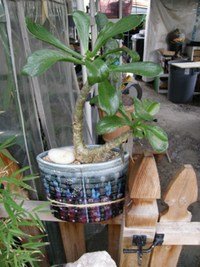
When space as it a minimum, hanging pots can help solve a lot of space problems... only pots that hang on flat surfaces are difficult to find. None of the above pots were meant to be used for live plants and none had draingage holes... No problem!
Another idea for potting succulents is using rocks as pot materials. One can sometimes find such rocks already drilled at places specializing in pottery, or succulents, or sometimes brick yards or quarry outlets. However the cost of these pre-drilled pots is often high, enticing me to try drilling my own rocks. In general, most rocks are pretty easy to drill a small hole into, but drilling a pot-sized hole is another matter entirely. For this I either drill a bunch of little holes (often one going all the way through) or, using a large bore attachment, I drill a large hole in one drilling. Getting this large cylinder out of the pot can be a bit of a challenge. I suspect that rocks drilled professionally are done with a sturdy press and the core drilled out is then twisted out carefully. Trying to twist out a large core can lead to sprained wrists or other painful injuries if one is using a hand drill and I certainly don't recommend trying. I have done it a few times while drilling out feather rock (aka razor rock), a super-light but sharp volcanic-glass-stone ideal for various succulent planting and staging projects. Feather rock should be handled with leather or tough garden gloves to prevent slicing up one's hands. But it is so light, large boulders can be moved about and drilled into with relative ease. I use this rock as often as I can since it's ideal for succulent pottery, building mounds, filling containers for planting around as well as in, and creating large stone statements without a bulldozer or back hoe. Lava rock is another igneous material ideal for planting succulents in. Both these rocks tend to have numerous natural drainage holes allowing rapid drying of the potting soil placed in their drilled holes or crevices. Many succulents grow naturally in rocks in nature, so planting succulents in such stones is not unique. However, few gardens make use of such planting surfaces.
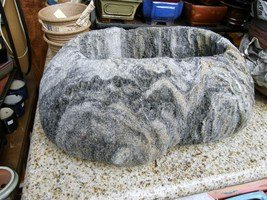
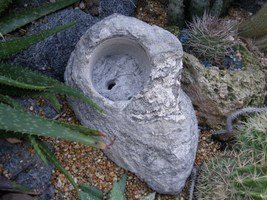
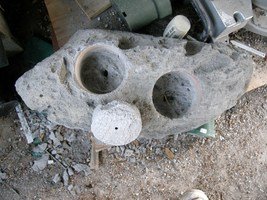
Professionally drilled razor rock pot (cost a fortune!) and my own home-made versions waiting for plants.
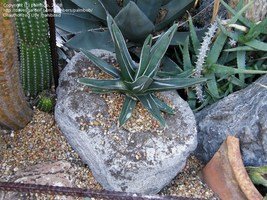
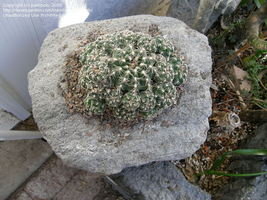
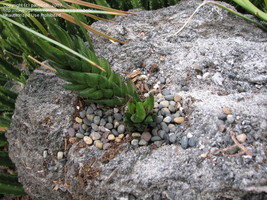
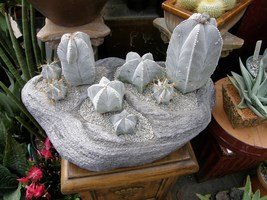
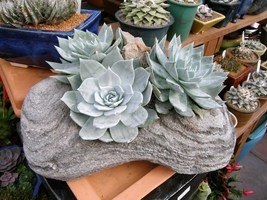
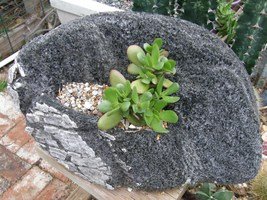
The above 6 photos show razor rock plantings- top three are my own creations, while two on bottom left/middle are 'professional' creations for sale
Then of course making one's own pots is another way around the lack of availability. If one has a kiln, or use of one, it doesn't take much money to obtain clay, and then one can make all the low, wide succulent pots they want. Making good looking pots is another story, and the end results may not be what one's looking for unless one's pretty good at making pots. I took a raku class at a local university and made pots for plants- raku is a hot-firing technique that makes use of a variety of metallic and ornamental glazes, though the clay has to be pretty thin. However, the completed pots are holding up well and are certainly different from what one would see anywhere else.
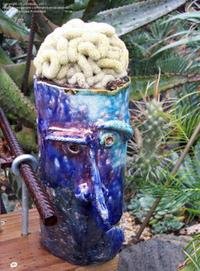
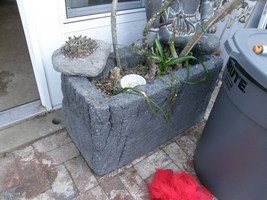
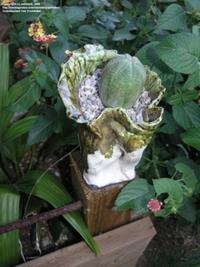
Examples of some of my raku pots used for succulents
There are also several methods of making hypertufa pots, which are excellent pots for succulents- light, inexpensive and often absorb water quickly and promote drainage. Hypertufa is a concrete combination one can easily make in the back yard. This is not a discussion on how to make hypertufa as I am sure someone else will write an article about that. You can also visit this discussion on hypertufa in Davesgarden:
 Hypertufa pot I purchased for my Plumeria... I will MAKE the next one myself
Hypertufa pot I purchased for my Plumeria... I will MAKE the next one myself
I find that cinder blocks can not only be useful for making small containers for gardening, they themselves can be used as pots, too. Stack them 2-3 high and one has a nice ready-made pot as well as a wall to a container or support. These may not be the most ornamental of pots and I do not use them for my best specimens, but they make convenient additional planting spaces for sprucing up small containers. These ‘pots' may actually fit the definition of container gardening better than pot gardening... not really sure where one ends the other begins. One can even go one step further and make small plant rings out of concrete or brick. This, to me, seems more obvious as a form of miniature container gardening, so will leaf that topic for the next article.
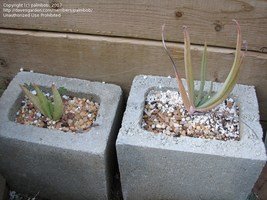
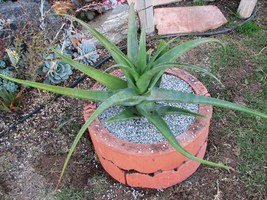
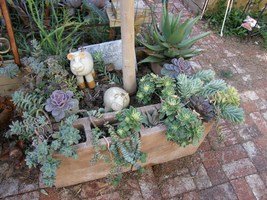
Not really sure these qualify as 'pots', versus being miniatures 'containers'. Function is the same, though.
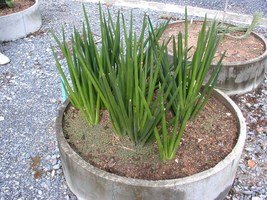
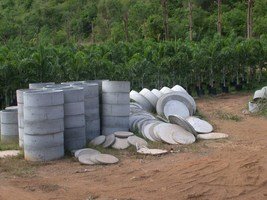
Two photos of 'pots'/containers frequently encountered in Thailand. These large concrete rounds could be stacked as high as desired and easily taken apart again- modular pots?
Another useful pot one can find in most nurseries, but way underutilized for growing succulents is the strawberry pot. These pots are great for all sorts of succulent groups and tend to remain on the dry side unless watered excessively.
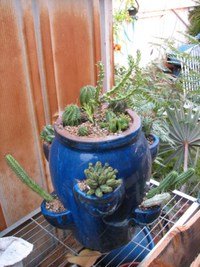
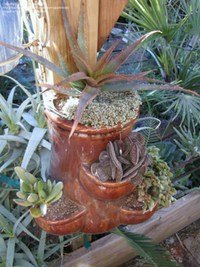
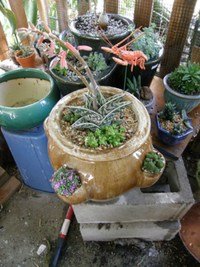
Euphorbias in strawberry pot A hanging strawberry-type pot Miniature strawberry pot
Another idea for succulent 'pots' is to fill of tube of some sort with potting soil and use these tubes to plant succulents in. Try anything your imagination comes up with.
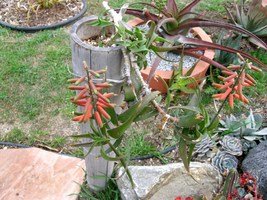
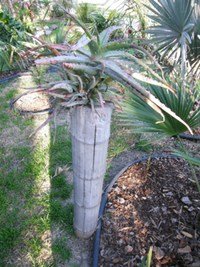
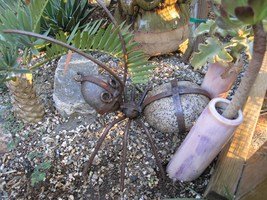
First two photos are of some aloes planted in bamboo posts sunk into the ground- these don't drain well unless you drill some holes in them. Third photo is of a very tall, skinny pot I broke the bottom off of and stuffed into a planter box, and planted an Aeonium in- doing great after 3 years!
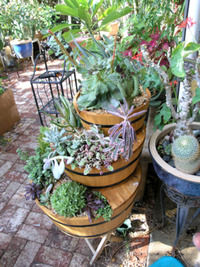
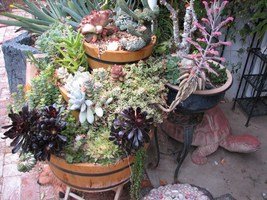
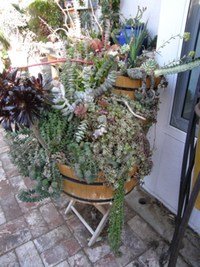
Three photos of same wooden fountain turned into a community succulent container/pot. First photo taken right after planting, the second a year later, and the third nearly 2 years later
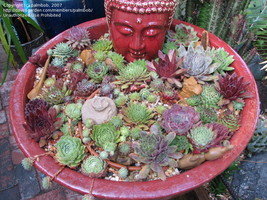
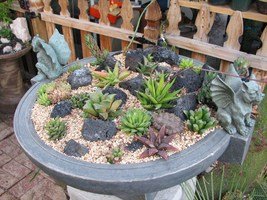
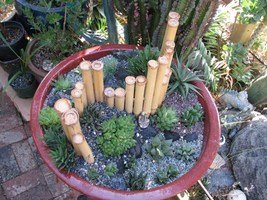
Large, shallow pots are easier to find than small ones for some reason, and though these may work well for really large succulents, they also work well for smaller community pots, such as the Sempervivum pot and the two Haworthia pots above
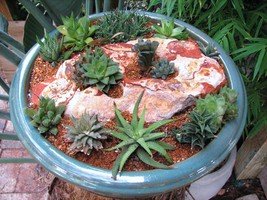
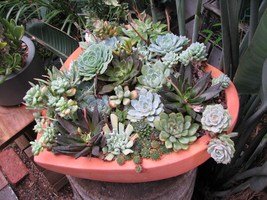
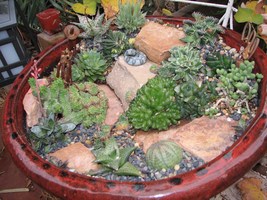
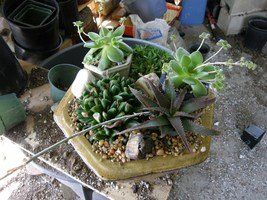
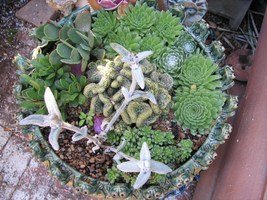
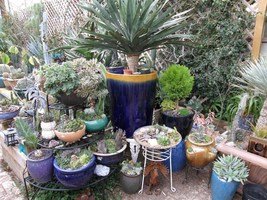
More community pots, and a shot of how we display some of our large succulent pots
Last, but certainly not least, is to seek out pots make specifically for succulents purposes. Bonsai pots sort of fit this description, and though can be quite pricey, make excellent pots for succulents and have been very popular pots for show purposes. But there are also plenty of succulent enthusiasts that have been making their own pots for years, partly in response to the lack of available pots, and partly because pot making is an artistic endeavor and can fulfill a lot of outlets for creativity and imagination... and of course, to make money. Pots specifically designed for succulents tend to be very ornamental , useful, well made and costly. And they are not always easy to find unless one looks online or goes to a succulent show and sale.
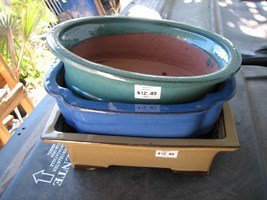
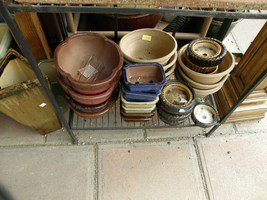
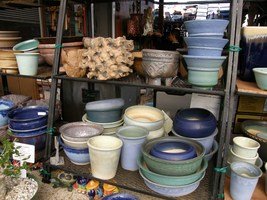
Sometimes one can find cheap bonsai pots. The rest of these photos are of pots found at specialty succulent nurseries and cactus shows
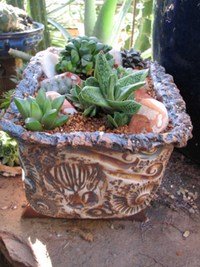
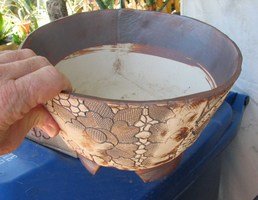
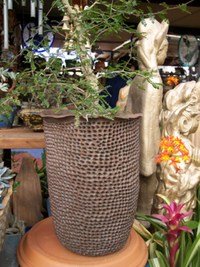
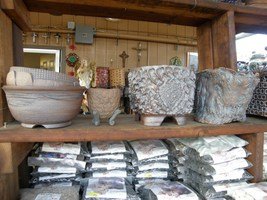
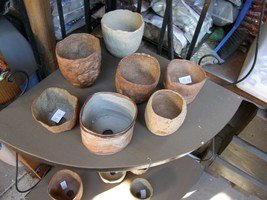
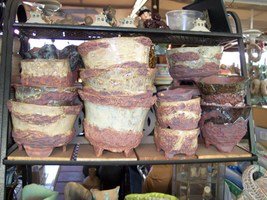
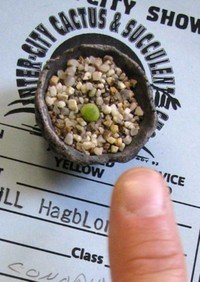
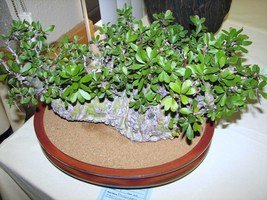
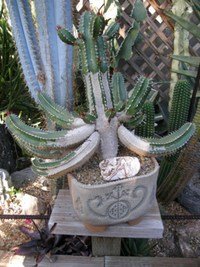
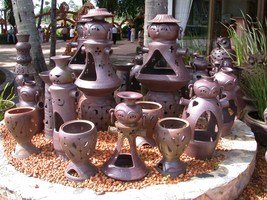
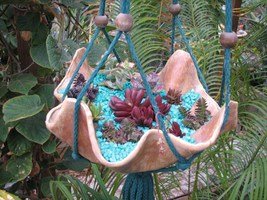
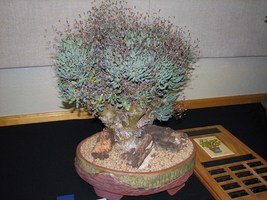
Specialty pots and pottery (some I have and some I just photographed at shows)
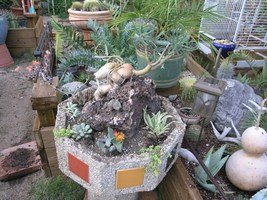
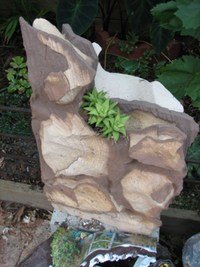
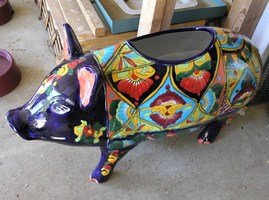
Some more somewhat unusal pots: concrete fountain, chunk of ornamental sandstone and a huge ceramic pig all make good succculent pots
One can make almost anything durable and draining into a pot for plants, and succulents are some of the easiest plants to grow in pots. All you need is an imagination and a sense of humor.
Copyright © www.100flowers.win Botanic Garden All Rights Reserved